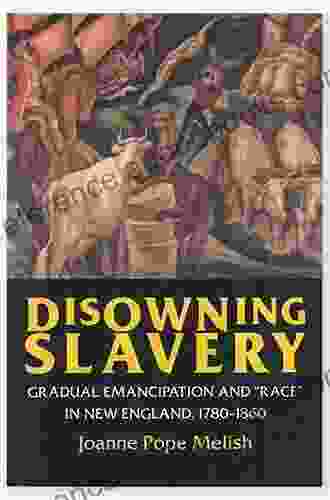Gradual Emancipation and Race in New England: Unraveling the Complexities of a Troubled Era

A Journey Towards Freedom: The Gradual Emancipation of Enslaved Individuals

4.6 out of 5
| Language | : | English |
| File size | : | 3208 KB |
| Text-to-Speech | : | Enabled |
| Screen Reader | : | Supported |
| Enhanced typesetting | : | Enabled |
| Word Wise | : | Enabled |
| Print length | : | 324 pages |
The history of race in New England is a complex and multifaceted tapestry woven with both the threads of oppression and the aspiration for justice. During the late 18th and early 19th centuries, New England played a pivotal role in the gradual emancipation of enslaved individuals, setting the stage for the eventual abolition of slavery in the United States.
In 1780, Massachusetts became the first state in the newly independent United States to gradually abolish slavery. The state legislature passed a law that declared that all enslaved individuals born after the enactment of the law would be free upon reaching the age of 21. This gradual approach to emancipation was a significant step towards ending the institution of slavery, although it did not immediately free all enslaved individuals in the state.
Over the following decades, other New England states followed Massachusetts's lead and passed their own gradual emancipation laws. In 1784, Connecticut passed a law that emancipated all enslaved individuals born after March 1, 1784, upon reaching the age of 25. Vermont abolished slavery outright in 1777, becoming the first state in the United States to do so.
By 1800, slavery had been abolished in all of the New England states except for Rhode Island. Rhode Island finally abolished slavery in 1842, making it the last state in New England to do so.
The Struggle for Racial Equality: Abolitionism and Resistance

While the gradual emancipation laws represented a major step forward in the fight against slavery, they did not end the struggle for racial equality in New England. Enslaved individuals and free Black people continued to face discrimination and prejudice in many aspects of life, including education, employment, and housing.
In the early 19th century, a movement known as abolitionism gained momentum in New England. Abolitionists were individuals who believed that slavery was morally wrong and should be abolished immediately, without any gradual process. They organized protests, petitioned the government, and worked to raise awareness about the horrors of slavery.
Some of the most prominent abolitionists in New England included William Lloyd Garrison, Wendell Phillips, and Frederick Douglass. Garrison was the founder of the New England Anti-Slavery Society, which published the influential abolitionist newspaper The Liberator. Phillips was a gifted orator who spoke out against slavery throughout the United States. Douglass was a former enslaved individual who became a leading abolitionist and author.
The abolitionist movement played a major role in the growing opposition to slavery in the United States. It helped to shape public opinion and to put pressure on politicians to take action against slavery.
The Legacy of Racial Injustice and the Ongoing Fight for Equality

The abolition of slavery in New England was a major victory for the cause of racial justice. However, the legacy of racial injustice continued to shape New England society in the years that followed. Black people continued to face discrimination and prejudice in many areas of life, and the gap between Black and white Americans in terms of wealth, education, and opportunity persisted.
In the 20th century, the Civil Rights Movement emerged as a powerful force for racial equality in the United States. The Civil Rights Movement led to the passage of landmark legislation such as the Civil Rights Act of 1964 and the Voting Rights Act of 1965, which outlawed discrimination based on race and ensured that all Americans had the right to vote.
Despite the progress made during the Civil Rights Movement, racial inequality remains a significant problem in the United States today. Black Americans continue to face discrimination in many areas of life, and the gap between Black and white Americans in terms of wealth, education, and opportunity persists.
The history of race in New England is a complex and sobering one, but it is also a story of hope and resilience. The people of New England played a major role in the fight against slavery and the struggle for racial equality. Their legacy inspires us to continue working towards a more just and equitable society for all.
4.6 out of 5
| Language | : | English |
| File size | : | 3208 KB |
| Text-to-Speech | : | Enabled |
| Screen Reader | : | Supported |
| Enhanced typesetting | : | Enabled |
| Word Wise | : | Enabled |
| Print length | : | 324 pages |
Do you want to contribute by writing guest posts on this blog?
Please contact us and send us a resume of previous articles that you have written.
 Book
Book Novel
Novel Page
Page Chapter
Chapter Text
Text Story
Story Genre
Genre Reader
Reader Library
Library Paperback
Paperback E-book
E-book Magazine
Magazine Newspaper
Newspaper Paragraph
Paragraph Sentence
Sentence Bookmark
Bookmark Shelf
Shelf Glossary
Glossary Bibliography
Bibliography Foreword
Foreword Preface
Preface Synopsis
Synopsis Annotation
Annotation Footnote
Footnote Manuscript
Manuscript Scroll
Scroll Codex
Codex Tome
Tome Bestseller
Bestseller Classics
Classics Library card
Library card Narrative
Narrative Biography
Biography Autobiography
Autobiography Memoir
Memoir Reference
Reference Encyclopedia
Encyclopedia Grace Marie Turner
Grace Marie Turner John M Alexander
John M Alexander Christopher Okigbo
Christopher Okigbo Tony Healey
Tony Healey Joy Deja King
Joy Deja King Jack Townsend
Jack Townsend Adi Kuntsman
Adi Kuntsman Lenae Burchell
Lenae Burchell Andy Ziker
Andy Ziker Abbe Smith
Abbe Smith Peter Geiger
Peter Geiger Adam Boxer
Adam Boxer Adam Gussow
Adam Gussow Abraham Lincoln
Abraham Lincoln Abrahan David Zaracho
Abrahan David Zaracho Malaka Gharib
Malaka Gharib Samara Klar
Samara Klar Aaron H Oliver
Aaron H Oliver John Jackson Miller
John Jackson Miller Amelia King
Amelia King
Light bulbAdvertise smarter! Our strategic ad space ensures maximum exposure. Reserve your spot today!

 José SaramagoUnveiling the Pardoner's Profound Tale: Chaucer's Masterpiece of Deception,...
José SaramagoUnveiling the Pardoner's Profound Tale: Chaucer's Masterpiece of Deception,...
 Caleb CarterThe Last Realm: Realm's Gate - A Fantasy Epic That Will Transport You to a...
Caleb CarterThe Last Realm: Realm's Gate - A Fantasy Epic That Will Transport You to a... Douglas FosterFollow ·8.4k
Douglas FosterFollow ·8.4k Robert HeinleinFollow ·19.8k
Robert HeinleinFollow ·19.8k Gil TurnerFollow ·10.3k
Gil TurnerFollow ·10.3k Hamilton BellFollow ·17.5k
Hamilton BellFollow ·17.5k Gene PowellFollow ·2k
Gene PowellFollow ·2k Eugene ScottFollow ·12.3k
Eugene ScottFollow ·12.3k Charlie ScottFollow ·11.1k
Charlie ScottFollow ·11.1k Samuel WardFollow ·3.4k
Samuel WardFollow ·3.4k

 Justin Bell
Justin BellUnlock National Biology Success: The Ultimate Guide to...
Mastering the Fundamentals: A Comprehensive...
 Luke Blair
Luke BlairAC/DC: The Early Years with Bon Scott – A Thunderstruck...
In the annals of rock and roll history, few...

 Darren Nelson
Darren NelsonSpinal Cord Medicine Second Edition: The Comprehensive...
The second edition of Spinal Cord Medicine...

 Cole Powell
Cole PowellArabian Horse Training: Unlock the Secrets for a...
Indulge in the captivating world of Arabian...

 Oscar Wilde
Oscar WildeRevise Curriculum For Excellence SQA Exams: The Ultimate...
The Scottish...

 David Peterson
David PetersonEndoscopic Ear Surgery: A Comprehensive Guide for...
Endoscopic Ear...
4.6 out of 5
| Language | : | English |
| File size | : | 3208 KB |
| Text-to-Speech | : | Enabled |
| Screen Reader | : | Supported |
| Enhanced typesetting | : | Enabled |
| Word Wise | : | Enabled |
| Print length | : | 324 pages |








